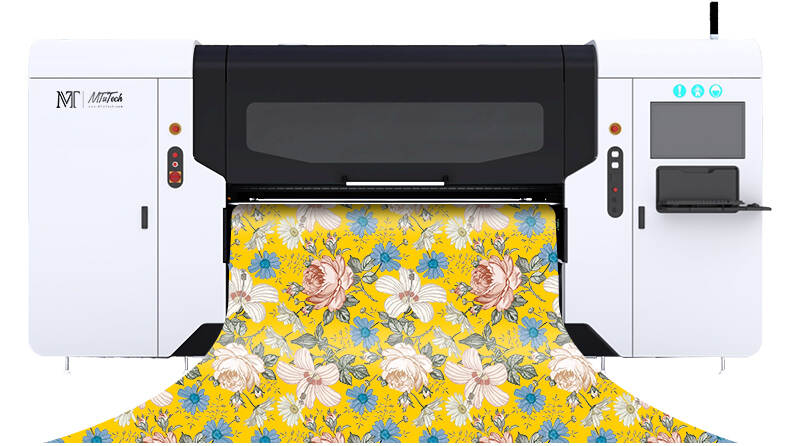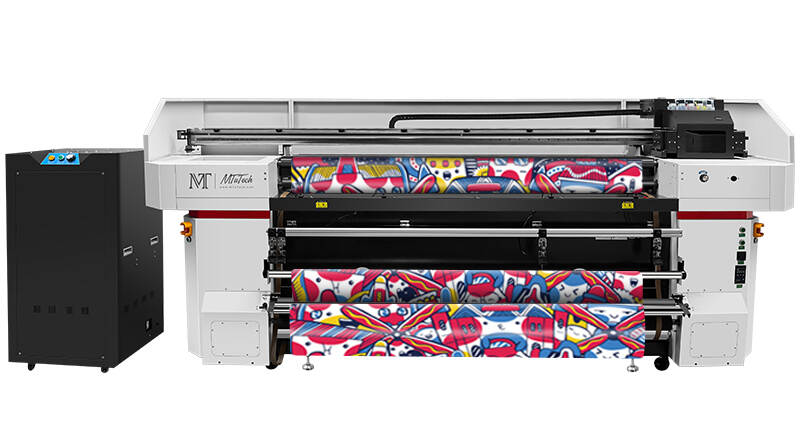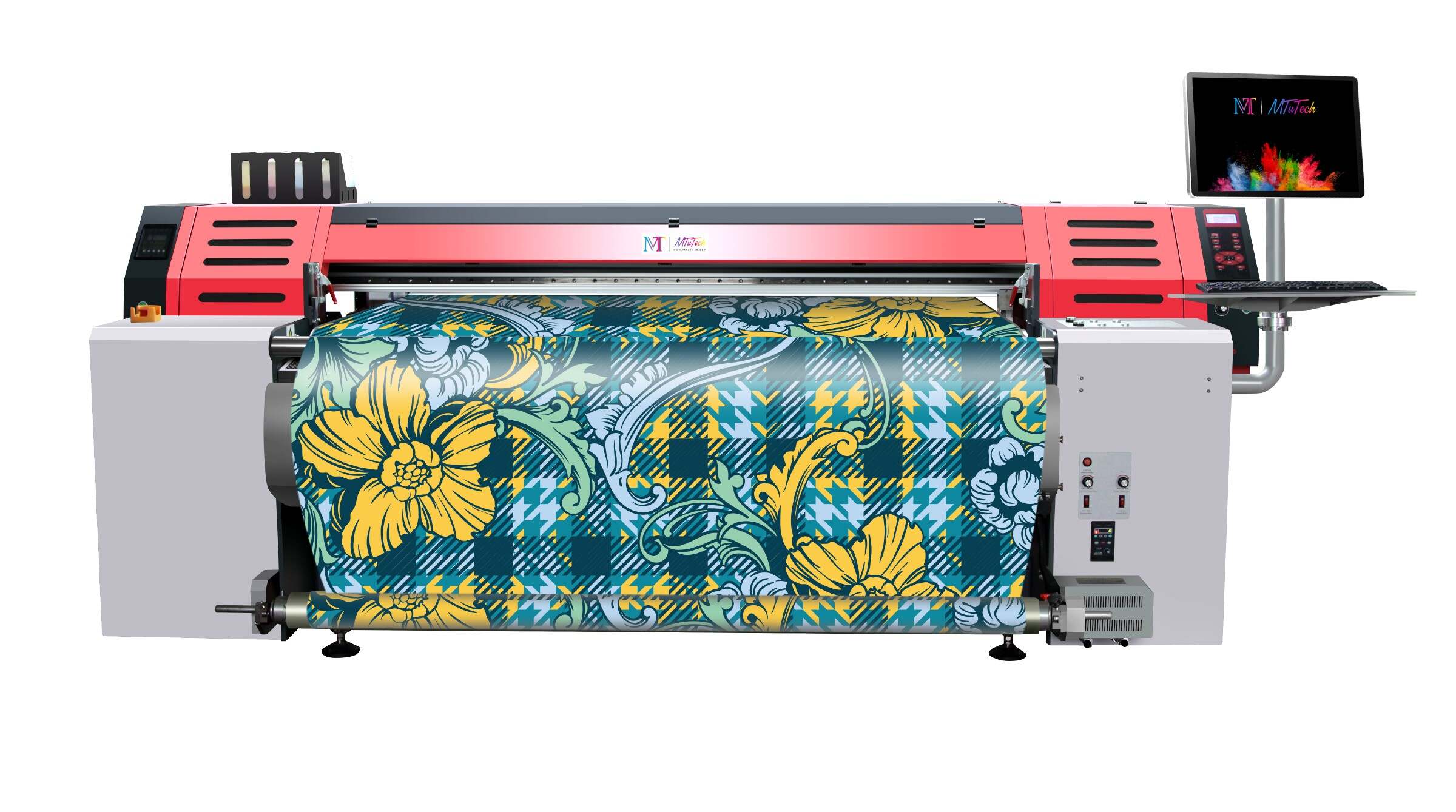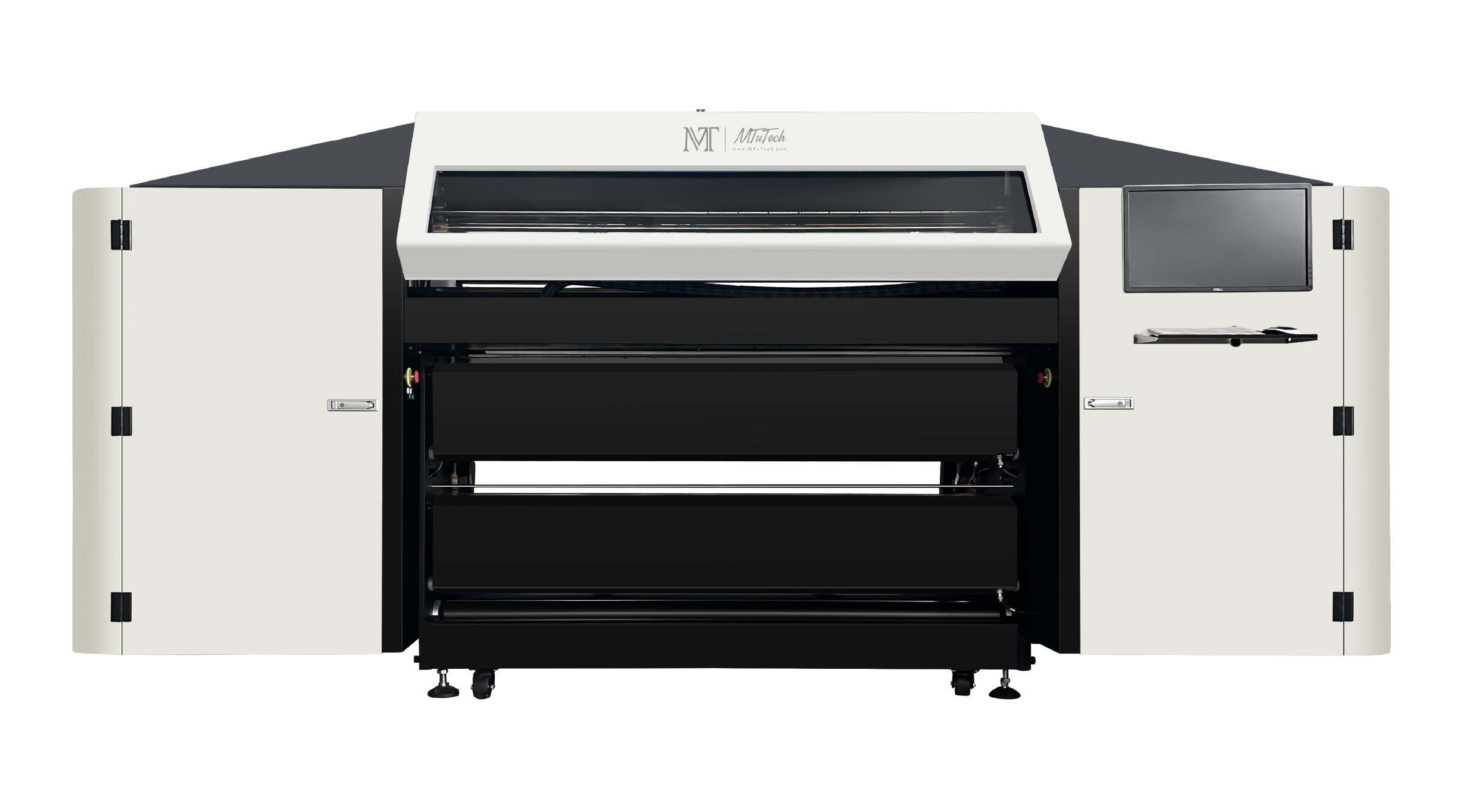Direct To Fabric Printer
Single Sided Direct to Fabric Printer Options
Professional Ricoh Gen6 Direct to Fabric Printer
Industrial Direct to Fabric Printer MT-TX 1816
Direct to fabric printer with top speed, top quality, and the highest flexibility.

| Model | MT - TX 1816 |
|---|---|
| Application | Suits for various fabric printing, cotton, silk, wool, polyester, nylon, blended, linen etc., widely used for home textile, fashion, upholstery etc. |
| Printing Mode | Single-sided Printing |
| Printhead | Ricoh Gen6 Printheads |
| Print Width | 1800mm (70.86'') |
| Colors | Wide gamut, up to 12 colors |
Entry Level Epson i3200 Direct to Fabric Printer
Direct To Fabric Printer MT-TXI3200
Made possible with four Epson I3200 printheads! Take a moment to enjoy the speed of digital Direct To Fabric Printer!

| Model | MT - TXI3200 |
|---|---|
| Application | Suits for soft signage, home textile and fashion apparel printing. |
| Printing Mode | Single-sided Printing |
| Printhead | Epson i3200 Printheads |
| Print Width | 2000mm (78.74'') |
| Colors | CMYK + LcLmLyLk |
Entry Level Epson i3200 Direct to Fabric Printer
Direct to Fabric Printer MT-Belt I3200Plus
Designed for both elastic and non-elastic fabric printing.

| Model | MT-Belt I3200Plus |
|---|---|
| Application | Suits for both elastic and non-elastic fabric printing, widely used for home textile, fashion, upholstery etc. |
| Printing Mode | Single-sided printing |
| Printhead | Epson i3200 printhead |
| Print Width | 1800mm (70.86 '') |
| Colors | CMYK |
|
MT - TX 1816
|
MT - TXI3200
|
MT-Belt I3200Plus
|
|
Suits for various fabric printing, cotton, silk, wool, polyester, nylon, blended, linen etc., widely used for home textile, fashion, upholstery etc.
|
Suits for soft signage, home textile and fashion apparel printing.
|
Suits for both elastic and non-elastic fabric printing, widely used for home textile, fashion, upholstery etc.
|
|
Single-sided Printing
|
Single-sided Printing
|
Single-sided printing
|
|
Ricoh Gen6 Printheads
|
Epson i3200 Printheads
|
Epson i3200 printhead
|
|
1800mm (70.86'')
|
2000mm (78.74'')
|
1800mm (70.86 '')
|
|
Wide gamut, up to 12 colors
|
CMYK + LcLmLyLk
|
CMYK
|
Model |
|---|
Application |
Printing Mode |
Printhead |
Print Width |
Colors |
Double Sided Direct to Fabric Printer Options
Ricoh Printhead Double-Sided Digital Textile Printer
Double-Sided Digital Textile Printer MT-DP100
The innovation of digital fabric printing machine, double-sided printing direct to fabric printer, opens a new printing experience!

| Model | MT-DP100 |
|---|---|
| Application | Textile printing solution for silk printing products with rich patterns, complex patterns, changeable colors, and a wide range of uses. |
| Printing Mode | Double-sided printing |
| Printhead | Ricoh Gen5 / Gen6 printheads |
| Print Width | 1000mm ( 39.37'') |
| Colors | CMYK |
Ricoh Printhead Double-Sided Digital Textile Printer
Double-Sided Digital Textile Printer MT-DP140
The innovation of digital fabric printing machine, double-sided printing direct to fabric printer, opens a new printing experience!

| Model | MT-DP140 |
|---|---|
| Application | Textile printing solution for silk printing products with rich patterns, complex patterns, changeable colors, and a wide range of uses. |
| Printing Mode | Double-sided printing |
| Printhead | Ricoh Gen5 / Gen6 printheads |
| Print Width | 1400mm ( 55.11'') |
| Colors | CMYK |
Ricoh Printhead Double-Sided Digital Textile Printer
Double-Sided Digital Textile Printer MT-DP180
The innovation of digital fabric printing machine, double-sided printing direct to fabric printer, opens a new printing experience!

| Model | MT-DP180 |
|---|---|
| Application | Textile printing solution for silk printing products with rich patterns, complex patterns, changeable colors, and a wide range of uses. |
| Printing Mode | Double-sided printing |
| Printhead | Ricoh Gen5 / Gen6 printheads |
| Print Width | 1800mm ( 70.86'') |
| Colors | CMYK |
|
MT-DP100
|
MT-DP140
|
MT-DP180
|
|
Textile printing solution for silk printing products with rich patterns, complex patterns, changeable colors, and a wide range of uses.
|
Textile printing solution for silk printing products with rich patterns, complex patterns, changeable colors, and a wide range of uses.
|
Textile printing solution for silk printing products with rich patterns, complex patterns, changeable colors, and a wide range of uses.
|
|
Double-sided printing
|
Double-sided printing
|
Double-sided printing
|
|
Ricoh Gen5 / Gen6 printheads
|
Ricoh Gen5 / Gen6 printheads
|
Ricoh Gen5 / Gen6 printheads
|
|
1000mm ( 39.37'')
|
1400mm ( 55.11'')
|
1800mm ( 70.86'')
|
|
CMYK
|
CMYK
|
CMYK
|
Model |
|---|
Application |
Printing Mode |
Printhead |
Print Width |
Colors |
Direct to Fabric Printer – The Ultimate Solution for High-Quality Textile Printing
When it comes to textile printing, the Direct to Fabric Printer stands as a game-changer. This advanced technology offers unparalleled versatility and efficiency, allowing businesses to print directly onto a variety of fabrics with vibrant, durable results. Whether you’re in the fashion industry, home textiles, or producing soft signage, this printer opens the door to unlimited possibilities. Let’s dive deep into the world of Direct to Fabric Printing and discover how it can revolutionize your business.
What is Direct to Fabric Printing?
Direct to Fabric Printing, often referred to as Roll-to-Roll Fabric Printing, is a cutting-edge method that allows designs, patterns, and graphics to be printed directly onto a roll of fabric. Unlike traditional methods, which require multiple steps and transfer processes, direct to fabric printers streamline the entire process, delivering speed, efficiency, and precision.
At MTuTech, we provide state-of-the-art Direct to Fabric Printers that cater to various industries. Whether you're in the fashion industry, home décor, or sportswear, our printers offer the versatility needed to produce outstanding results on a wide range of fabric types. From cotton to silk, polyester, and blends, the possibilities are endless.
Why Choose Direct to Fabric Printing?
In today’s fast-paced environment, businesses need reliable technology that delivers both speed and quality. Direct to Fabric Printing offers the perfect balance, with benefits that set it apart from traditional printing methods.
1. Unmatched Versatility
Whether it’s cotton, polyester, silk, or a blend, direct to fabric printing works seamlessly across all fabric types. This means you no longer have to limit your creative ideas to specific materials.
2. High-Speed Production
The continuous roll-to-roll printing process allows for faster production times. Whether you’re fulfilling small custom orders or handling bulk production, the efficiency of a direct to fabric printer ensures you can meet tight deadlines without sacrificing quality.
3. Eco-Friendly Solution
As sustainability becomes increasingly important, direct to fabric printing provides an eco-friendly alternative. By eliminating the need for transfer papers and other intermediate materials, it reduces waste and minimizes environmental impact.
4. Cost-Effective
Lower production costs while maintaining high-quality output. The streamlined process of a direct to fabric printer cuts down on labor and material costs, giving businesses a competitive edge in pricing.
5. Vibrant, Long-Lasting Prints
Our printers deliver high-resolution images with brilliant color vibrancy. The inks penetrate deep into the fabric fibers, ensuring that your designs are both vibrant and durable, even after multiple washes.
Key Applications of Direct to Fabric Printers
Direct to Fabric Printing is not limited to one industry—it serves a broad range of applications. Here’s a look at how different sectors are benefiting from this revolutionary technology:
1. Fashion and Apparel
Customization is king in today’s fashion world. With a direct to fabric printer, fashion brands can produce one-of-a-kind garments with intricate designs. From runway collections to streetwear, this technology allows designers to create unique pieces without the traditional limitations of fabric printing.
2. Home Textiles
Curtains, upholstery, bedding, and even table linens can be enhanced with custom prints. Interior designers and home décor companies use direct to fabric printing to bring their creative visions to life.
3. Soft Signage
From retail banners to exhibition displays, direct to fabric printers can produce stunning soft signage with bold colors that captivate audiences. The fabric-based signs are lightweight, easy to transport, and eco-friendly.
4. Sportswear
Activewear brands can use direct to fabric printing to create high-performance sportswear with custom designs. Whether it's team jerseys, yoga wear, or fitness gear, the flexibility of this technology ensures precision and durability.
Expanding Fabric Printing Technologies
The world of fabric printing technology is vast, with innovations like the fabric printing machine, textile printers, and digital fabric printing leading the charge. These technologies allow for sublimation printing, which is ideal for synthetic fabrics, and reactive printing, which works perfectly on natural fibers. With roll-to-roll printing, businesses can produce continuous fabric designs at a higher speed, offering a sustainable solution that reduces waste. By adopting these advanced methods, companies can enjoy eco-friendly, sustainable fabric printing options that align with modern production needs, all while maintaining vibrant, long-lasting prints.
Choosing the Right Direct to Fabric Printer
When selecting a direct to fabric printer, it’s essential to consider the specific needs of your business. MTuTech offers a range of models designed to cater to both small-scale operations and large production facilities. Whether you're looking for an entry-level machine or a high-capacity industrial printer, we have the perfect solution.
Key factors to consider include:
Printing Speed: For businesses with high demand, a printer that offers fast speeds without compromising quality is crucial.
Ink Compatibility: Different fabrics require different inks. Ensure that the printer you choose can handle the types of ink best suited for your fabric type—whether it's reactive, pigment, or sublimation ink.
Size and Scale: Whether you're printing narrow fabrics for fashion or wide rolls for signage, choosing the right printer size can make all the difference in your production workflow.
The Future of Textile Printing is Here
As the textile industry continues to evolve, businesses must adopt technologies that allow them to stay competitive. Direct to Fabric Printers offer the flexibility, speed, and quality needed to thrive in today’s market. With the ability to print on demand, create custom designs, and reduce production costs, the benefits of this technology are too significant to ignore.
At MTuTech, we’re dedicated to providing our customers with the best direct to fabric printing solutions. Our printers are designed with the user in mind, offering easy operation, minimal maintenance, and consistent results. Ready to revolutionize your textile printing business? Explore our range of Direct to Fabric Printers and take the next step toward innovation.
Learn More About Direct to Fabric Printing and Sustainable Textile Solutions
For those looking to dive deeper into the advancements in textile printing and sustainable solutions, there are several valuable resources. The Digital Textile Printing Overview on Wikipedia provides an in-depth look at how digital fabric printing has evolved.
For more insights into innovative textile printing solutions, you can check out FuturePrint, where they explore cutting-edge fabric printing technologies and how they apply to a wide range of materials, including textiles and fabrics. To learn more about advancements in fabric printing, visit Phoseon Technology for detailed insights into UV LED curing technology, which enhances the performance of Direct to Fabric Printers, ensuring faster, high-quality results on various fabric surfaces.
FAQs About Direct to Fabric Printing
Q1: What fabrics can be printed with a direct to fabric printer?
A: Direct to fabric printers are highly versatile and can print on various fabrics, including cotton, polyester, silk, wool, and blended fabrics. This makes them an ideal choice for businesses working with different types of textiles.
Q2: How eco-friendly is direct to fabric printing?
A: Direct to fabric printing is an eco-friendly process because it eliminates the need for transfer papers and reduces waste. The inks used are often water-based and non-toxic, contributing to a more sustainable production process.
Q3: How does the quality of direct to fabric printing compare to traditional methods?
A: Direct to fabric printing offers superior quality, with high-resolution images and vibrant colors. The inks penetrate the fabric fibers, making the prints more durable and resistant to fading, even after multiple washes.
Q4: What industries benefit most from direct to fabric printing?
A: Direct to fabric printers are widely used in industries like fashion and apparel, home textiles, soft signage, and sportswear. Their versatility makes them an ideal choice for any business that requires high-quality, custom fabric prints.
Q5: How cost-effective is direct to fabric printing compared to traditional methods?
A: Direct to fabric printing is more cost-effective in the long run. It reduces labor costs, minimizes waste, and speeds up production time. These factors combine to lower overall production costs while maintaining premium quality.



